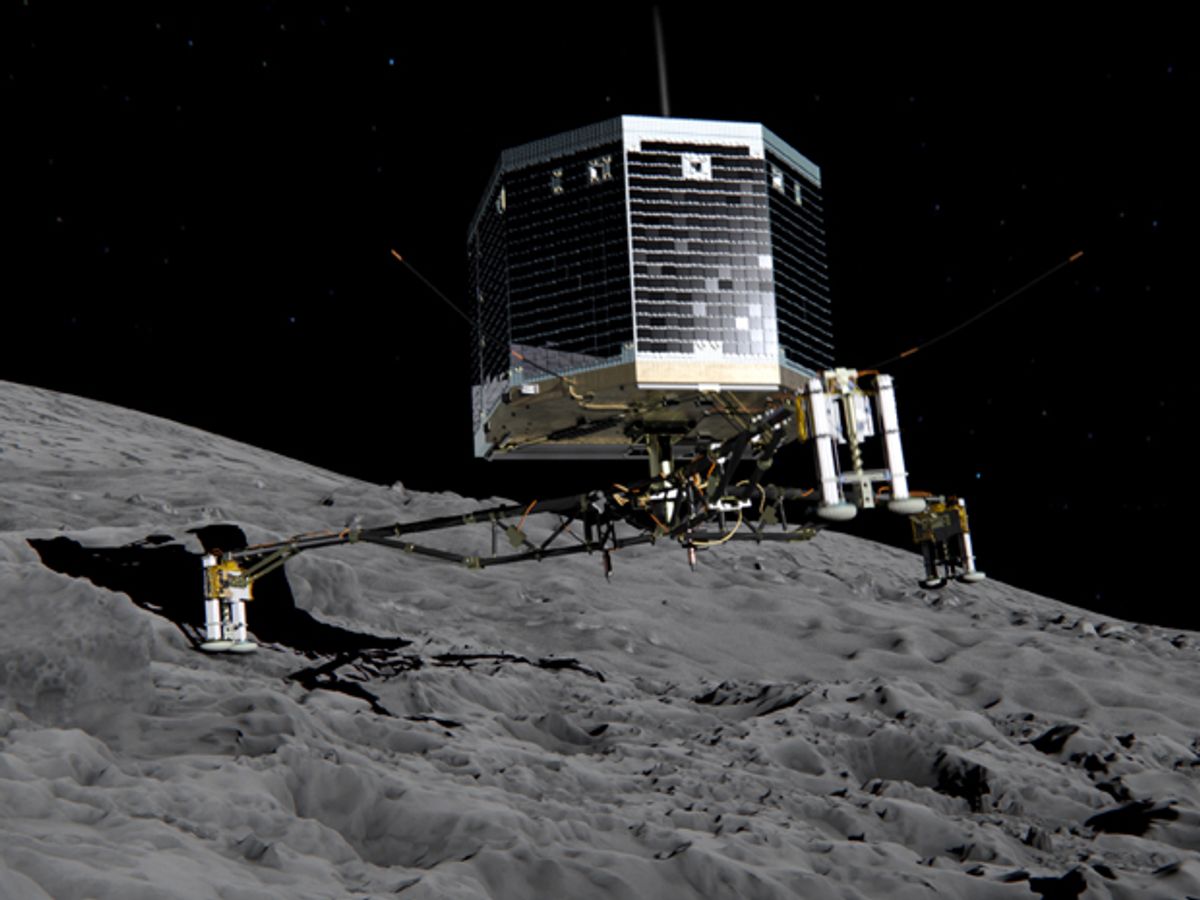Update 14 Nov 2014: 16:10 GMT Philae’s drill has been deployed. It’s a race against time now to get as much data out of the lander’s science instruments before battery power is exhausted. The Philae team hopes to get another data update this evening. They’re still discussing ways, such as panel rotation or a hop with the landing gear, to get more solar power to the lander. Stephan Ulamec, the lander manager, says that it’s possible Philae could wake up again as the comet gets closer to the sun. A replay of an update from team members via Google Hangouts can be viewed here.
Update 13 Nov 2014: 17:00 GMT Data from Philae suggests the lander bounced twice before coming to rest on the comet. The lander is anchored by neither its harpoons, which failed to fire, nor the ice screws at its feet. Team members are exploring ways to move the lander so that it can get better illumination; Philae is receiving an estimated 90 minutes of sunlight every 12 hours, which is not expected to be enough to sustain the lander after its battery power is exhausted, which could happen in less than two days.
Update 12 Nov 2014: 19:50 GMT At a media briefing a few hours after the landing, the team confirmed Philae’s harpoons did not fire and so are not fixing the lander to the comet’s surface. The spacecraft may have moved from its initial landing spot. Another press briefing is slated for 13 Nov at 13:00 GMT.
Journey’s end? After a decade-long trek, the European Space Agency’s Rosetta mission has performed the first soft landing on the surface of a comet. But it’s not yet clear if the mission’s lander, Philae, is in a secure position.
Philae detached from the Rosetta orbiter around 08:35 GMT. After about 7 hours of free fall and about a half hour of waiting for Philae’s signals to be relayed through the orbiter and on to Earth, the Rosetta team was all smiles. ”We are on the comet,” ESA’s Philae lander manager Stephan Ulamec said, speaking from the mission’s control room a few minutes after 11 AM EST (1600 GMT).
To land on duck-shaped Comet 67P/Churyumov-Gerasimenko, which is currently about 500 million kilometers from Earth, Philae was designed to use a thruster to help push it toward the comet close to touchdown and harpoons and foot screws to fix it to the comet’s low-gravity surface. As prime time approached, the team found it could not get the thruster to work, but decided to proceed anyway, relying only on the ice screws, harpoons, and a hopefully soft surface.
Just after landing, the team said it had confirmed that Philae’s two harpoons had been deployed. But it now seems the harpoons did not fire, which might mean the lander has a very tenuous hold on the surface; 67P’s surface gravity is hundreds of thousands of times weaker than Earth’s. ESA is posting updates on Twitter at @ESAOperations and @PhilaeLander, among other places. We’ll update this story as more information comes in.
If Philae can stay fixed and in a place with ample sunlight, it could operate on the comet’s surface for up to three months, depending on how well its solar cells and back-up batteries perform. Rosetta’s orbiter will follow the comet as it gets closer to the sun and begins jettisoning hundreds of liters of water per second and after the comet’s closest approach in August 2015.
Rachel Courtland, an unabashed astronomy aficionado, is a former senior associate editor at Spectrum. She now works in the editorial department at Nature. At Spectrum, she wrote about a variety of engineering efforts, including the quest for energy-producing fusion at the National Ignition Facility and the hunt for dark matter using an ultraquiet radio receiver. In 2014, she received a Neal Award for her feature on shrinking transistors and how the semiconductor industry talks about the challenge.



